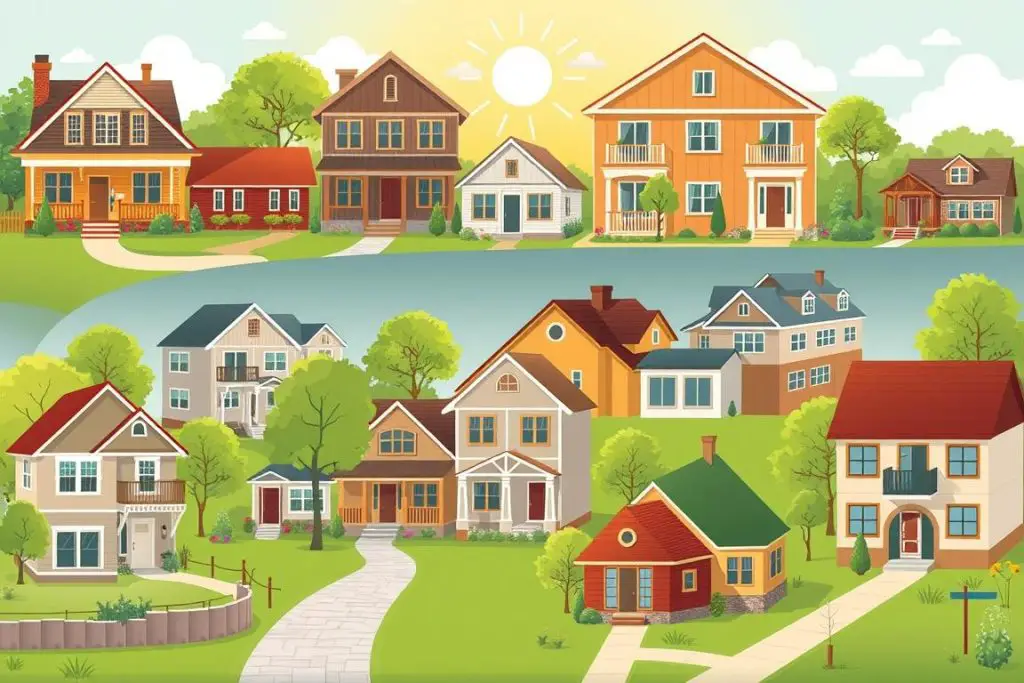Did you know over 5 million people in more than 2 million families get help from the Housing Choice Voucher program every year? This huge number shows the big need for housing help in the United States1. With real estate and rent prices going up, finding an affordable place to live is key for those with lower incomes. Luckily, many options are available to help you get a stable place to live and a home to call your own.
Learning about the different government and local programs for housing can help you make smart choices for your future. Whether it’s housing choice vouchers, local shelters, or subsidized homes, there’s something for everyone in need. This guide will help you understand these options better, so you can find affordable housing more easily.
Key Takeaways
- Over 5 million people benefit from the Housing Choice Voucher program annually1.
- Housing assistance options include vouchers, local shelters, and subsidized homes.
- Understanding your eligibility is crucial to securing affordable housing.
- Various programs cater to different needs—rental assistance, homebuyer support, and homelessness prevention.
- HUD and local PHAs play a significant role in administering these programs1.
Understanding Government Housing Assistance Programs
Government housing help is crucial for those with low income, the elderly, and disabled folks. They offer housing choice vouchers to aid in finding homes. These vouchers help find housing on the private market that’s safe and affordable.
What are housing choice vouchers?
Housing choice vouchers, known as Section 8, let people pick their housing if it’s safe and healthy. In Michigan, the MSHDA helps over 29,000 families in all 83 counties with these vouchers2. They are urged to look for housing in diverse areas to live in varied communities2.

Eligibility requirements
To get a housing voucher, your income, family size, and citizenship matter. The government sets income limits to focus on those who need it most3. Interestingly, while the majority of U.S. households are “White, not Hispanic,” they make up only a third of those getting rental help3.
How to apply for a voucher
To apply, contact your local Public Housing Agency (PHA). They check your income, family size, and housing needs. Participants could also enter programs that support self-sufficiency and homeownership2. There’s even special help for homeless veterans through the HUD VASH Program2.
To find more about these programs and see if you’re eligible, check the federal housing program information page.
Roles and responsibilities
Running government housing programs needs teamwork. Tenants, landlords, PHAs, and HUD must all work together. PHAs give out the vouchers and make sure rules are followed. Renters need to stick to their lease and keep up their homes. Landlords must ensure their rentals are safe and budget-friendly. HUD handles the funding and rules3.
In 2023, $67 billion was set aside for housing help, with $53 billion for key programs3. This funding helps millions of households every year3.
Housing Support Programs for Low-Income Families
Finding housing help for low-income families can be hard. Many programs are out there, from local agencies to full support for buyers. Learn about the various programs to help low-income families find a stable place to live.
Local Housing Resources and Agencies
Local housing resources help low-income families with advice and finding affordable rentals. For instance, Pennsylvania Housing Finance Agency has a tool and a bilingual helpline at 1-877-428-88444. The Housing Choice Vouchers program helps low-income families, the elderly, and disabled people find safe homes4.
Homelessness Prevention and Stability Services
Preventing homelessness is key to keeping families stable. The Treasury’s Emergency Rental Assistance programs gave over $46 billion for renter support during the pandemic5. They made 10 million assistance payments to prevent evictions, focusing on low-income and minority renters5. These programs, along with others, stopped millions of evictions since the pandemic began5.
Subsidized Housing Options
Subsidized housing helps many low-income families. State and federal programs offer affordable housing to those in need. The ERA initiatives provided over $46 billion to help families afford their homes, with bills from 2021 backing this funding5. For rural areas, the U.S. Department of Agriculture shares housing information by county4.
Additional Support for Homebuyers
Low-income families seeking to buy homes have support too. They can access discounted HUD homes and special mortgage programs. Resources like COMPASS and County Assistance Offices offer benefits info at 1-800-692-74624. Pennsylvania aims to make housing more accessible and affordable, updating its Housing Strategy for 2024-2029 to help residents4.
Conclusion
Services that make housing affordable play a key role in helping people and families thrive in the long run. They guide you through programs like housing choice vouchers and show you how to find local support. By using these programs, you can greatly better your living situation and take a big step towards getting an affordable home.
Looking at the numbers, it’s clear how much families need good housing support. For example, the Housing First approach has a success rate of up to 98% in keeping people in their homes for a year6. These efforts save money and make lives better by providing stable homes and improving health76. Studies show that well-run housing programs also cut down on healthcare expenses, making life better overall78.
In summary, getting help with housing is key to laying down a stable foundation. By exploring the help available, you can make smart choices about your home. Whether you need help with rent or buying a house, there’s guidance out there. Equip yourself with this knowledge, and start your journey to a safe, stable future.
FAQ
What are housing choice vouchers?
Housing choice vouchers, or Section 8 vouchers, help very low-income people, old folks, and the disabled afford good housing. These vouchers are given out by Public Housing Agencies (PHAs). They cover part of the rent for approved private homes.
What are the eligibility requirements for housing choice vouchers?
To get a housing voucher, your yearly income and family size matter. Your income must be less than half of what most people earn in your area. The program looks out for those with very low income, the elderly, or disabled. Local PHAs, following HUD’s rules, check if you qualify.
How do I apply for a housing voucher?
To apply, reach out to your local PHA. They’ll tell you what documents you need, like proof of income and family size. After they check your application, you might go on a waiting list until vouchers are ready.
What are the roles and responsibilities of tenants, landlords, PHAs, and HUD in the housing choice voucher program?
Tenants must find a good place to live, pay some rent, and stick to their lease. Landlords need to keep housing safe and will get part of the rent from the PHA. PHAs run the program, help both sides, and give out vouchers. HUD oversees everything, making sure the program works well.
What local housing resources and agencies are available for low-income families?
For low-income families, local non-profits, community agencies, and housing departments can help. They offer advice, help find affordable places to live, and support in emergencies. They can guide you through the process of getting government housing help.
What services are available for homelessness prevention and housing stability?
Services to prevent homelessness and stabilize housing include financial help for rent or bills, case management, and support like counseling and job help. There are also programs aimed at quickly housing those without a home, to get them settled fast.
What subsidized housing options exist for low-income families?
For low-income families, there’s public housing, private subsidized housing, and housing choice vouchers. Public housing is affordable housing provided by local PHAs. In private subsidized housing, landlords get subsidies to lower rent for eligible tenants. Vouchers help families rent in the private market with government aid.
What additional support is available for low-income homebuyers?
For those wanting to buy a home, there’s the HUD Good Neighbor Next Door program, offering big discounts to some public service workers. The Housing Choice Voucher Program can also help with mortgage payments. Plus, state housing finance agencies have special mortgages and down payment help for low-income families.
Source Links
- Federal programs for affordable housing – Local Housing Solutions – https://localhousingsolutions.org/fund/federal-programs-for-affordable-housing/
- Housing Choice Voucher Program Overview – https://www.michigan.gov/mshda/rental/housing-choice-voucher/housing-choice-voucher-program-overview
- The Federal Government’s Support for Low-Income Housing Expanded during the Pandemic – https://www.pgpf.org/blog/2024/04/how-does-the-federal-government-support-housing-for-low-income-households
- Housing Resources | Department of Human Services – https://www.pa.gov/en/agencies/dhs/resources/for-residents/housing-resources.html
- Emergency Rental Assistance Program – https://home.treasury.gov/policy-issues/coronavirus/assistance-for-state-local-and-tribal-governments/emergency-rental-assistance-program
- Housing First – https://endhomelessness.org/resource/housing-first/
- Housing First: A Review of the Evidence – https://www.huduser.gov/portal/periodicals/em/spring-summer-23/highlight2.html
- Conclusions and Recommendations – Permanent Supportive Housing – https://www.ncbi.nlm.nih.gov/books/NBK519587/




